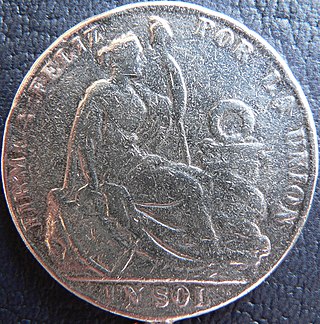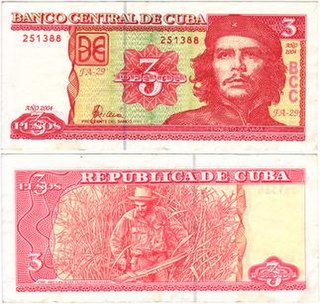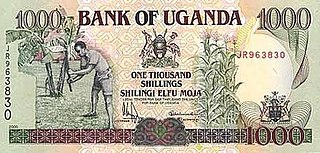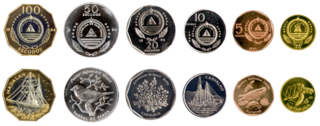
The schilling was the currency of Austria from 1925 to 1938 and from 1945 to 1999, and the circulating currency until 2002. The euro was introduced at a fixed parity of €1 = 13.7603 schilling to replace it. The schilling was divided into 100 groschen.

The Portuguese escudo was the currency of Portugal replacing the real on 22 May 1911 and was in use until the introduction of the euro on 1 January 2002. The escudo was subdivided into 100 centavos. The word escudo literally means shield; like other coins with similar names, it depicts the coat of arms of the state.

The Macanese pataca or Macau pataca is the currency of Macau. It is subdivided into 100 avos, with 10 avos called ho (毫) in Cantonese.

The córdoba is the currency of Nicaragua and is divided into 100 centavos.

The Sucre was the currency of Ecuador between 1884 and 2000. Its ISO code was ECS and it was subdivided into 10 decimos and 100 centavos. The sucre was named after Latin American political leader Antonio José de Sucre. The currency was replaced by the United States dollar as a result of the 1998–99 financial crisis.

The sol, later sol de oro, was the currency of Peru between 1863 and 1985. It had the ISO 4217 currency code PES. It was subdivided into 10 dineros or 100 centavos. It also had two different superunits over its circulation life, the inca (1881–1882) and later the gold pound, both worth 10 soles.

The Colombian peso is the currency of Colombia. Its ISO 4217 code is COP. The official peso symbol is $, with Col$. also being used to distinguish it from other peso- and dollar-denominated currencies.

The Cuban peso also known as moneda nacional, is the official currency of Cuba.

The shilling is the currency of Uganda. Officially divided into cents until 2013, due to substantial inflation the shilling now has no subdivision.

The Dominican peso, officially the peso dominicano since 2010, is the currency of the Dominican Republic. Its symbol is "$", with "RD$" used when distinction from other pesos is required; its ISO 4217 code is "DOP". Each peso is divided into 100 centavos ("cents"), for which the ¢ symbol is used. With exception of the United States dollar, it is the only currency that is legal tender in the Dominican Republic for all monetary transactions, whether public or private.
The colón was the currency of El Salvador from 1892 until 2001, when it was replaced by the U.S. dollar during the presidency of Francisco Flores. The colón was subdivided into 100 centavos and its ISO 4217 code was SVC. The plural is "colones" in Spanish and the currency was named after Christopher Columbus, known as Cristóbal Colón in Spanish.

The escudo is the currency of the Republic of Cape Verde. One escudo is subdivided into one hundred centavos.

The escudo was the currency of Portuguese India between 1958 and 1961. It was subdivided into 100 centavos and was equal in value to the Portuguese escudo. After Goa was integrated by the Republic of India in 1961, the escudo was replaced by the Indian rupee.
The peso was the currency of Paraguay between 1856 and 1944. It replaced the real at a rate of 8 reales = 1 peso. Until 1870, the peso was subdivided into 8 reales. Paraguay then decimalized, with 100 centésimos = 1 peso. The name of the subdivision was changed to centavo in 1874. The peso was replaced in 1944 by the guaraní at a rate of one hundred to one.

The dinar was the currency of South Arabia, and then South Yemen, and the Republic of Yemen after Yemen's monetary unification on 1 July 1990. It was one of the two official currencies used in Yemen until 11 June 1996. It was subdivided into 1000 fils (فلس).

The escudo was the currency of São Tomé and Príncipe between 1914 and 1977. It was equivalent to the Portuguese escudo and subdivided into 100 centavos.

The escudo was the currency of Angola between 1914 and 1928 and again between 1958 and 1977. It was subdivided into 100 centavos with the macuta worth 5 centavos and was equivalent to the Portuguese escudo.
The angolar was the currency of Portuguese Angola between 1928 and 1958. It was subdivided into 100 centavos or 20 macutas. Angolar is Portuguese for "of Angola".
The pataca was a monetary unit of account used in Portuguese Timor between 1894 and 1958, except for the period 1942–1945, when the occupying Japanese forces introduced the Netherlands Indies gulden and the roepiah. As in the case of the Macanese pataca which is still in use today, the East Timor unit was based on the silver Mexican dollar coins which were prolific in the wider region in the 19th century. These Mexican dollar coins were in turn the lineal descendants of the Spanish pieces of eight which had been introduced to the region by the Portuguese through Portuguese Malacca, and by the Spanish through the Manila Galleon trade.

The franc was the currency of Tunisia between 1891 and 1958. It was divided into 100 centimes (صنتيم) and was equivalent to the French franc.


















